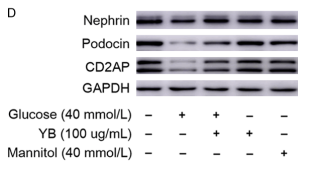Podocin Antibody - #DF8593
| Product: | Podocin Antibody |
| Catalog: | DF8593 |
| Description: | Rabbit polyclonal antibody to Podocin |
| Application: | WB |
| Cited expt.: | WB |
| Reactivity: | Human |
| Prediction: | Mouse, Pig, Bovine, Horse, Sheep, Rabbit, Dog |
| Mol.Wt.: | 42 kDa; 42kD(Calculated). |
| Uniprot: | Q9NP85 |
| RRID: | AB_2841797 |
Related Downloads
Protocols
Product Info
*The optimal dilutions should be determined by the end user. For optimal experimental results, antibody reuse is not recommended.
*Tips:
WB: For western blot detection of denatured protein samples. IHC: For immunohistochemical detection of paraffin sections (IHC-p) or frozen sections (IHC-f) of tissue samples. IF/ICC: For immunofluorescence detection of cell samples. ELISA(peptide): For ELISA detection of antigenic peptide.
Cite Format: Affinity Biosciences Cat# DF8593, RRID:AB_2841797.
Fold/Unfold
Nephrosis 2, idiopathic, steroid resistant (podocin); nephrosis 2, idiopathic, steroid resistant; NPHS2; NPHS2 gene; PDCN; PODO_HUMAN; Podocin; SRN1;
Immunogens
A synthesized peptide derived from human Podocin, corresponding to a region within C-terminal amino acids.
Almost exclusively expressed in the podocytes of fetal and mature kidney glomeruli.
- Q9NP85 PODO_HUMAN:
- Protein BLAST With
- NCBI/
- ExPASy/
- Uniprot
MERRARSSSRESRGRGGRTPHKENKRAKAERSGGGRGRQEAGPEPSGSGRAGTPGEPRAPAATVVDVDEVRGSGEEGTEVVALLESERPEEGTKSSGLGACEWLLVLISLLFIIMTFPFSIWFCVKVVQEYERVIIFRLGHLLPGRAKGPGLFFFLPCLDTYHKVDLRLQTLEIPFHEIVTKDMFIMEIDAICYYRMENASLLLSSLAHVSKAVQFLVQTTMKRLLAHRSLTEILLERKSIAQDAKVALDSVTCIWGIKVERIEIKDVRLPAGLQHSLAVEAEAQRQAKVRMIAAEAEKAASESLRMAAEILSGTPAAVQLRYLHTLQSLSTEKPSTVVLPLPFDLLNCLSSPSNRTQGSLPFPSPSKPVEPLNPKKKDSPML
Predictions
Score>80(red) has high confidence and is suggested to be used for WB detection. *The prediction model is mainly based on the alignment of immunogen sequences, the results are for reference only, not as the basis of quality assurance.
High(score>80) Medium(80>score>50) Low(score<50) No confidence
Research Backgrounds
Plays a role in the regulation of glomerular permeability, acting probably as a linker between the plasma membrane and the cytoskeleton.
Isoform 2 is glycosylated.
Cell membrane>Peripheral membrane protein.
Endoplasmic reticulum.
Almost exclusively expressed in the podocytes of fetal and mature kidney glomeruli.
Belongs to the band 7/mec-2 family.
References
Application: WB Species: Mouse Sample: kidney tissues
Application: WB Species: Human Sample: podocytes
Restrictive clause
Affinity Biosciences tests all products strictly. Citations are provided as a resource for additional applications that have not been validated by Affinity Biosciences. Please choose the appropriate format for each application and consult Materials and Methods sections for additional details about the use of any product in these publications.
For Research Use Only.
Not for use in diagnostic or therapeutic procedures. Not for resale. Not for distribution without written consent. Affinity Biosciences will not be held responsible for patent infringement or other violations that may occur with the use of our products. Affinity Biosciences, Affinity Biosciences Logo and all other trademarks are the property of Affinity Biosciences LTD.



